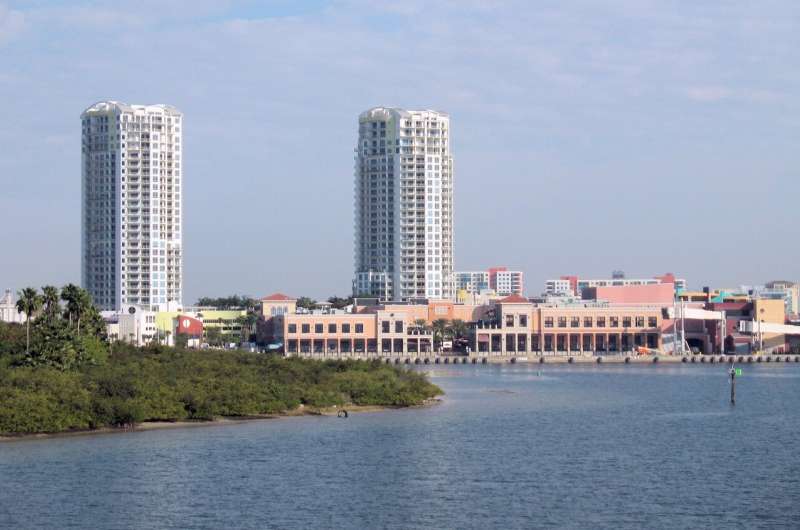This article has been reviewed according to Science X's editorial process and policies. Editors have highlighted the following attributes while ensuring the content's credibility:
fact-checked
reputable news agency
proofread
Tampa's fall nights are getting hotter: Why researchers worry

A new study from researchers at Embry–Riddle Aeronautical University found temperatures are rising during the fall months across the biggest cities in the state. And Tampa is getting the worst of it.
Last fall and summer, Florida experienced a cycle of record-setting heat fueled by unusually high levels of humidity, which prevents temperatures from falling as much as they normally would overnight.
In September, the Tampa Bay area broke a new record after 37 consecutive days with a feels-like temperature of 100 degrees or higher. Last October was the hottest October in the area since record-keeping began in 1890.
Kelsey Ennis, who co-authored the study as an undergraduate meteorology student at Embry–Riddle, said this is part of a larger trend caused by climate change, and Floridians—especially those living on the state's peninsula—are feeling the heat from our warming oceans.
"Sea surface temperatures are increasing around the globe," she said. "And so Florida is kind of in the line of fire."
The study looked at eight cities across the state during fall and found all of them saw larger increases in heat stress, which occurs when the body overheats. Tampa led this trend with the most extreme rise in nighttime temperatures since 1950.
But why Tampa?
Oceans absorb heat during the day which is then trapped overnight, Ennis said. And because the Gulf of Mexico runs hotter than the Atlantic Ocean, Florida's west coast often experiences warmer air temperatures as a result.
The Gulf reached record-warm temperatures last summer, triggering a massive coral die-off along reefs. And it wasn't just a fluke: sea surface temperatures in the Gulf of Mexico have increased twice as fast as the global ocean average since 1970, according to a study published last year.
The urban heat island effect is also at play: roads, buildings and other human-made surfaces absorb and retain heat in a similar way to coastal waters.
"If you're closer to water, you're going to feel more of an effect," Ennis said. "Especially in an urban area where you have much more heat trapped in a city."
Many people think all heat is the same, Ennis said. But warm, humid nights can often be more dangerous than days when the sun is out.
Agricultural workers, older people and low-income households living without air conditioning are at the greatest risk of heat stroke and other heat-related illness, she added.
"This study really showed that a lot of vulnerable communities in Florida were subjected to nighttime heat stress, which can pose a lot of health problems," she said.
Shawn Milrad is a professor of meteorology at Embry-Riddle who co-authored the study with his former student Ennis. Milrad said when temperatures don't cool down at night, it can disrupt sleep.
"Extremes at night are more hazardous to health than extremes during the day in a lot of cases, because it sort of prevents the body's ability to recover," he said.
Their research also found that Tampa is seeing two more "extra extreme nights" each decade, when conditions are more uncomfortable than 90% of other nights during fall.
Autumn is a particularly important season to study heat in Florida because water temperatures peak in September, Milrad said. And hot waters bring warmer air.
When the oceans are warmer, they cause more water to evaporate into the air and increasing humidity near the coast. And because water vapor is a potent greenhouse gas, this process helps trap heat in the atmosphere and warm the planet.
"So for coastal locations it is a bit of a double or even triple whammy," Milrad said. "The warming water not only increases the humidity in the air through evaporation but the increased water vapor in the air also prevents the temperature from falling as much."
This cycle is also one reason why Tampa's fall temperatures are increasing more rapidly over the previous 10 years than in decades past, he added.
Milrad says Tampa's heat sticks out even when compared to the entire Southeast, thanks to the city's proximity to the water, huge urban footprint and location far enough south where cold fronts don't come until much later in the fall.
"It's sort of a confluence of a bunch of favorable factors that make it have some of the largest heat trends not just within Florida, but within the entire southeast U.S.—I would say within the entire U.S. really," he added.
Ennis' parents live in Lutz, and she says every time she visits, Ennis is reminded just how much warmer the air feels near the Gulf.
"I'm not surprised that heat stress is getting worse in Tampa," she said. "Tampa is expanding: It's growing, it's becoming bigger, more people are moving there."
"It's always just so hot. You just don't get a break. In fall it feels like second summer almost."
2024 Tampa Bay Times. Distributed by Tribune Content Agency, LLC.




















